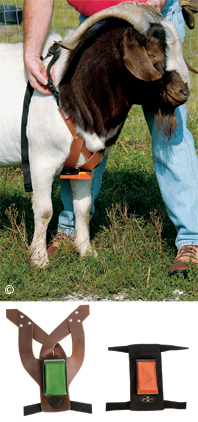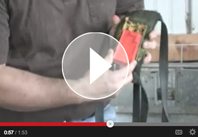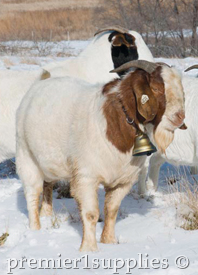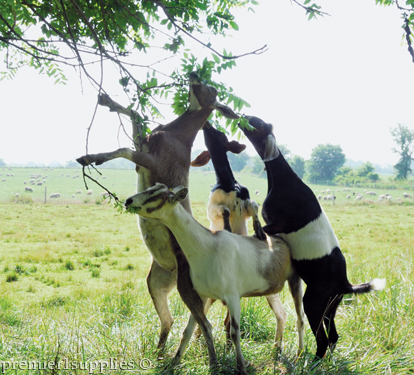HARNESSES & CRAYONS

Cross Your Heart Breeding Harness.
Most users need to re-adjust the harness weekly (active bucks lose weight during breeding). Change crayon colors to record which week does were marked.
Breeding Harnesses
Crayons
For use with either the Nylon or Cross Your Heart breeding harness. A metal cotter pin and 2 plastic pins supplied with each crayon. Plastic case protects crayons during transport.
Available in 3 temperature ranges. Temperature range (based on average daily high).
The mark’s scourability is disputed. The Kiwi manufacturer says it is. However, ASI’s tests indicate that this is not always true.
BREEDING HARNESS HOW-TO
"Mark" your
breeding season
Breeding harnesses and crayons are invaluable tools during the breeding season. They identify which does have been bred and whether or not the bucks are pulling their weight.
We run breeding groups through our handling equipment weekly during the breeding season to check the does that have been bred, record their ear tag number and the date. Five months down the road we sort by ear tag and date and get the nannies into our kidding jugs. We wouldn't be able to do this w/o the aid of a marking harness.
HOW-TO VIDEO

Click above to view our "how-to replace crayons on a ram marking harness".
GOAT ACCOUTREMENTS

Our Boer billy modeling a Ram Bell and collar. The bell's tone lets us know the location of our goat herd in the pasture. For ear tags, check out our Q-flex® line of scrapie approved tags.
It says Ram Bell but it works for bucks too!
It's a heavy-duty bell for use on rams or bucks. Can be laser imprinted with the buck's name or your name/address in case he decides to go for a walkabout.
Collars
Best used for holding buck (ram) bells. Made of a tough nylon that can handle the most ornery of goats. 26" long. Fits around the necks of most does. Measure the neck of the goat before ordering the collar. We are sourcing a larger collar.
|
 |
 |

Low hanging branches are not safe from these voracious browsers.
Goats & Brush
Goats for Vegetation Management
By Steve Hart, Langston University
Meat Goat Handbook
Unit Objective
After completion of this module of instruction the producer should be able to state reasons why producers should manage vegetation on the family farm and why goats are a good animal for vegetation management. The producer should know the advantages of co-grazing goats and cattle and be able to select the proper stocking rate for goats grazing with cattle. The producer should be able to score a minimum of 85% on the module test.
Specific Objectives
After completion of this instructional module the producer should be able to:
| 1. |
Match terms with the correct definition. |
| 2. |
State the purpose of using goats for vegetation management.
|
| 3. |
State reasons why producers should manage vegetation.
|
| 4. |
Identify options producers have for vegetation management.
|
| 5. |
Distinguish between mechanical and chemical vegetation control.
|
| 6. |
State the compatibility of goats with cattle.
|
| 7. |
Select the proper stocking rate of goats in combination with cattle.
|
| 8. |
Identify management factors to consider when using goats for vegetation management.
|
| 9. |
State ways for making fence modifications to control/contain goats on the property.
|
| 10. |
State the meaning of 10-47-12 when related to wire fence.
|
| 11. |
State the meaning of the statement “rent-a-goat.”
|
| 12. |
Identify some constraints for operating a rent-a-goat program.
|
| 13. |
Describe goat vegetation management in Oklahoma.
|
| 14. |
Develop an individual farm vegetation management program.
|
Read More »
AN OPTION FOR GOAT FEEDING
Silage for Goats
By John Hibma
Dairy Goat Journal
Goats are natural browsers in the wild, being very selective of what they eat. If the seasonal nutritive values of browse and other feedstuffs decline or fluctuate, silage can be a good alternative, especially in production situations that require consistent nutrition on a daily basis.
Feeding silage to goats is generally safe but does come with some risks and challenges. There is nothing inherently wrong with feeding silage to goats. Like all ruminants, goats can digest fermented feeds quite well. However, as with all forages, quality and nutritional value, as well as price, should be the deciding factors when considering feeding silage to dairy goats. While silages are an excellent way to preserve forages, improperly processing, ensiling and possible mishandling after ensiling can result in a dangerous product that will have an ill effect on goats. As with any forage, maturity and preparation at the time of harvest is critical to its quality and nutritional value.
Silage is the product formed when a forage crop such as grass, alfalfa or corn is fermented so as to preserve it in a state of high moisture while at the same time preventing it from decay. In theory, any organic material containing sugar or starch can be ensiled provided there’s enough of it to justify the effort. Ensiling grass is a good alternative to baling when the weather doesn’t cooperate.
The key to making good silage is to use the weight of the crop to squeeze out all of the air, arresting the natural process of oxidation and decay after the crop has been harvested. There are essentially three ways of ensiling crops: in a vertical silo (the kind visible on many dairy farms throughout the country), in horizontal bunkers (usually constructed of cement floors and walls), and in the long, plastic, tubular bags that are generically referred to as “ag bags” by those in the know. Each method, when done correctly, will yield high quality silage for animal feed.
In Riverdale, California, Tony Brady milks about 1,800 goats—mostly Saanens—and has been feeding them silage as part of their diet for over 10 years. He feeds both corn silage and oat silage and ensiles them in ag bags. Brady said that when he first put up silage, he tried the pit style bunker and his herd developed major health issues. Two hundred goats died. He said there was never a positive conclusion reached as to what caused the deaths, but the silage was heavily implicated. His suspicion was that something went awry with fermentation in a poorly packed bunker. He’s been using ag bags ever since with no problems. Brady feels the ag bags give him much better control of the ensiling process.
The ensiling process is one of fermentation and acidification, where naturally occurring bacteria consume the starches and sugars present in the forage, eventually consuming all of the oxygen and shutting off the decaying process. Once the proper level of acidity has been reached in the pile, the organic matter will then stabilize and cool, leaving a sweet smelling, “pickled” product that will keep for many months, sometimes years, so long as it isn’t disturbed and more oxygen is introduced, which will begin the decaying process all over again.
The single most important factor to consider when ensiling any forage is the moisture content at the time of harvest. The bacteria need a certain amount moisture to synthesize the fermentation acids. There are a number of fermentation acids that develop in a pile of silage. The good ones are lactic acid and acetic acid. The bad ones are propionic acid and butyric acid. Secondary by-products such as ammonia and alcohol are also formed during fermentation.
Lactic acid should be the predominant acid present in any silage. It is odorless so there is no way to tell how much is present without a laboratory test. The presence of lactic acid from 8% to 10% indicates a good fermentation and the fermentation process progressed rapidly with a minimum of total spoilage in the pile. Acetic acid will also be present in silages and should be about 1/3 the level of lactic acid. The smell of acetic acid is similar to that of vinegar. If there’s a lot of acetic acid present, it indicates the pile went through a slower fermentation with a greater loss of organic matter usually due to slow packing of the bunk or the forage was too dry when harvested. There’s no real danger of high acetic acid levels in a silage pile; it only indicates that the pile took longer to stabilize and more organic matter vanished into thin air before the oxidation process came to an end. The longer a pile takes to stabilize, the greater the chance of undesirable bacteria getting into the silage such as clostridiums.
Read More »
|
|